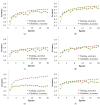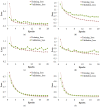Automated Battery Making Fault Classification Using Over-Sampled Image Data CNN Features
- PMID: 36850526
- PMCID: PMC9965985
- DOI: 10.3390/s23041927
Automated Battery Making Fault Classification Using Over-Sampled Image Data CNN Features
Abstract
Due to the tremendous expectations placed on batteries to produce a reliable and secure product, fault detection has become a critical part of the manufacturing process. Manually, it takes much labor and effort to test each battery individually for manufacturing faults including burning, welding that is too high, missing welds, shifting, welding holes, and so forth. Additionally, manual battery fault detection takes too much time and is extremely expensive. We solved this issue by using image processing and machine learning techniques to automatically detect faults in the battery manufacturing process. Our approach will reduce the need for human intervention, save time, and be easy to implement. A CMOS camera was used to collect a large number of images belonging to eight common battery manufacturing faults. The welding area of the batteries' positive and negative terminals was captured from different distances, between 40 and 50 cm. Before deploying the learning models, first, we used the CNN for feature extraction from the image data. To over-sample the dataset, we used the Synthetic Minority Over-sampling Technique (SMOTE) since the dataset was highly imbalanced, resulting in over-fitting of the learning model. Several machine learning and deep learning models were deployed on the CNN-extracted features and over-sampled data. Random forest achieved a significant 84% accuracy with our proposed approach. Additionally, we applied K-fold cross-validation with the proposed approach to validate the significance of the approach, and the logistic regression achieved an 81.897% mean accuracy score and a +/- 0.0255 standard deviation.
Keywords: SMOTE; deep learning; fault detection; image classification; machine learning.
Conflict of interest statement
The authors declare no competing interest.
Figures







Similar articles
-
An approach to automatic fault detection in four-point system for knitted fabric with our benchmark dataset Isl-Knit.Heliyon. 2024 Aug 23;10(17):e35931. doi: 10.1016/j.heliyon.2024.e35931. eCollection 2024 Sep 15. Heliyon. 2024. PMID: 39676831 Free PMC article.
-
An Imbalanced Fault Diagnosis Method Based on TFFO and CNN for Rotating Machinery.Sensors (Basel). 2022 Nov 12;22(22):8749. doi: 10.3390/s22228749. Sensors (Basel). 2022. PMID: 36433352 Free PMC article.
-
Evaluation of Different Bearing Fault Classifiers in Utilizing CNN Feature Extraction Ability.Sensors (Basel). 2022 Apr 26;22(9):3314. doi: 10.3390/s22093314. Sensors (Basel). 2022. PMID: 35591006 Free PMC article.
-
Scale-Fractal Detrended Fluctuation Analysis for Fault Diagnosis of a Centrifugal Pump and a Reciprocating Compressor.Sensors (Basel). 2024 Jan 11;24(2):0. doi: 10.3390/s24020461. Sensors (Basel). 2024. PMID: 38257554 Free PMC article.
-
A Survey of Image-Based Fault Monitoring in Additive Manufacturing: Recent Developments and Future Directions.Sensors (Basel). 2023 Jul 31;23(15):6821. doi: 10.3390/s23156821. Sensors (Basel). 2023. PMID: 37571604 Free PMC article. Review.
Cited by
-
Malicious Vehicle Detection Using Layer-Based Paradigm and the Internet of Things.Sensors (Basel). 2023 Jul 20;23(14):6554. doi: 10.3390/s23146554. Sensors (Basel). 2023. PMID: 37514847 Free PMC article.
-
Coarse-to-Fine Localization for Detecting Misalignment State of Angle Cocks.Sensors (Basel). 2023 Aug 22;23(17):7311. doi: 10.3390/s23177311. Sensors (Basel). 2023. PMID: 37687767 Free PMC article.
References
-
- Borah R., Hughson F., Johnston J., Nann T. On battery materials and methods. Mater. Today Adv. 2020;6:100046. doi: 10.1016/j.mtadv.2019.100046. - DOI
-
- Lee S.S., Kim T.H., Hu S.J., Cai W.W., Abell J.A. Joining technologies for automotive lithium-ion battery manufacturing: A review; Proceedings of the International Manufacturing Science and Engineering Conference; Erie, PA, USA. 12–15 October 2010; pp. 541–549.
-
- Brand M.J., Schmidt P.A., Zaeh M.F., Jossen A. Welding techniques for battery cells and resulting electrical contact resistances. J. Energy Storage. 2015;1:7–14. doi: 10.1016/j.est.2015.04.001. - DOI
-
- Fonseka C., Jayasinghe J. Implementation of an automatic optical inspection system for solder quality classification of THT solder joints. IEEE Trans. Compon. Packag. Manuf. Technol. 2018;9:353–366. doi: 10.1109/TCPMT.2018.2864666. - DOI
LinkOut - more resources
Full Text Sources

